|
A weekend in Lithuania
2008 Vilnius (Part 3) Vilnius (Part 3) 
|
Vilnius University has a great location in the old town. It's also one of the oldest Universities in Northern Europe.
The Grand Courtyard of Vilnius University is a historic place. It lies beside the Church of St. John (sorry, I couldn't take any really good pictures from this one).
I have already talked about this, but this University handles the unique research Center for Stateless Cultures. This interesting institute is "dedicated exclusively to cultures that have no army or navy, no military power or sovereign status anywhere on earth". |
|
On this part of the city you have a nice complex featuring St. Francis and St Bernardine Church, a Bernadine Monastery and the gothic St. Anne's Church.
Bernardine monks (Franciscans) built a church here in 1469. The church was a part of the city's defensive wall.
During the 16th and 17th centuries renaissance and baroque elements were added.
After World War II the Soviets gave the church to the Art Institute but in 1994 it returned to the Bernardines.
When I visited it was under restoration inside, but still magnificent, with a nice mural painting, wooden statues and baroque altars.
By the way, the oldest known crucifix in Lithuania, dating only from the 15th century, is here.
The Bernardine monastery dates from the 15th century and was famous for its manuscripts. It houses nowadays the Vilnius Academy of Art. |
|
The gothic church of St. Anne is one of the greatest buildings in Vilnius.
The first church in this site was built in the honour of Anna, the first wife of Grand Duke Vytautas, but it was destroyed by fire, this time in 1419. The church you see today dates from around 1500.
During the Franco-Russian War of 1812 Napoleon is known to have said that wished to carry the church with him to Paris “in the palm of his hand”. |
|
As it’s said on this monument, on August 23, 1987 the Lithuanian Freedom League held the first public protest against Soviet occupation.
This aimed to re-establish the independence of Lithuania from the USSR.
The other monument in front of the church is a statue of Adomas Mickevičius (Adam Mickiewicz), one of the greatest Polish poets.
He was born near Nowogródek, a town once in the Polish-Lithuanian Commonwealth but today in Belarus.
Lithuania, Poland and Belarus all claim his nationality, but most of his works were written in Polish. |
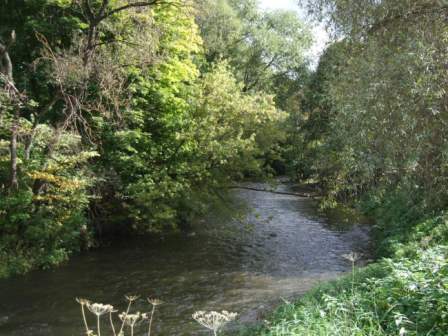 |
Gediminas Tower is the only remaining of the Upper Gediminas Castle in Vilnius.
Unfortunately access was closed when I visited the city.
Anyway, the hill is surrounded by a very pleasant park and I was really surprised to have a view like this one from the river, in the middle of the city.
A reconstruction of the Royal Palace of Lithuania is taking place at the bottom of the hill, on the site where it was once. Itís scheduled to be completed on July 6, 2009. |
|
Gediminas was the ruler of the Grand Duchy of Lithuania from 1316 to 1341.
This pagan monarch resisted all attempts to Christianize his country, although he allowed Christian communities to settle on his lands.
Now his statue stands just beside the Vilnius Cathedral. |
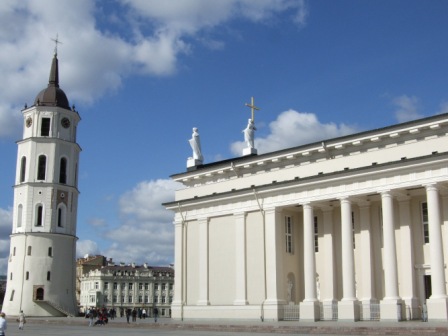 |
It is believed that on this site there was a pagan temple to Perkunas, the God Of Thunder, before the cathedral was built.
During restoration works, altars of what seems to be a pagan temple were discovered.
The first cathedral was built here in 1251 by King Mindaugas when he converted to Christianity.
However, Mindaugas returned to paganism ten years later and in 1263 it became a Pagan temple again. |
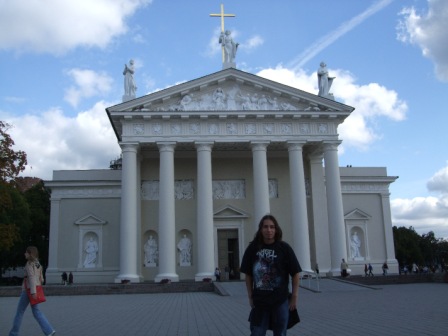 |
A second Cathedral, this time in Gothic style, was built in 1387 when Lithuania was converted to Christianity.
Like almost all the others churches I visited in Vilnius, it burnt sometime. This happened in 1419, but Grand Dike Vytautas rebuilt a bigger one, still in Gothic style.
In 1530 there was another fire and the Cathedral was rebuilt in Renaissance style but... fire came again in 1610!
The present building in neoclassical style dates from 1801. |
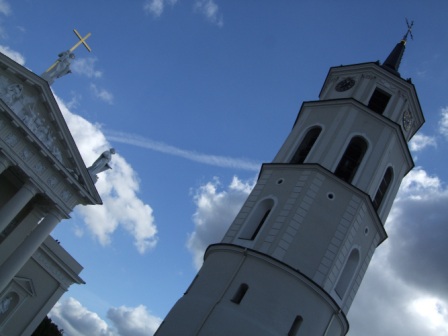 |
Some restoration works are still going on, but they’re scheduled to finish during 2008, not long after my visit.
There are three sculptures on roof: Saint Casimir on the left, Saint Stanislaus on the right and Saint Helena in the centre.
These sculptures were removed during most of the Soviet period.
It’s said that the sculpture of St. Casimir originally symbolised Lithuania, the one of St. Stanislaus symbolised Poland, and the sculpture of St. Helena symbolised Russia's dominance. |
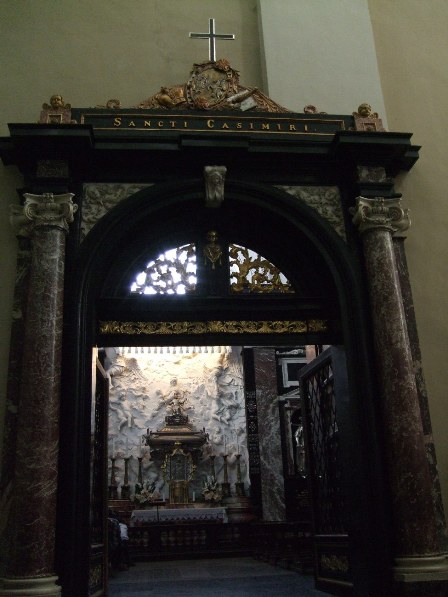 |
Vilnius Cathedral is decorated with some fabulous paintings. The oldest known fresco in Lithuania is here. It dates from the 14th Century, when Lithuania adopted Christianity.
Grand Dukes of Lithuania were crowned here, and you can find in the crypt some rulers like Vytautas the Great and his wife Anna.
The Baroque style Chapel of St. Casimir was built in the 17th Century. Its beautifully decorated with fine frescoes and a magnificent altar. It's the resting place of St Casimir, patron saint from Poland and Lithuania.
Casimir was a member of the Lithuanian Royal Family from the Jagiellon Dynasty, and heir-apparent to the throne of Poland.
He was born in 1458 at the Wawel, the Royal Castle in Krakow, Poland. He had a very pious life and was canonized saint in the 16th Century. |
|
|
|